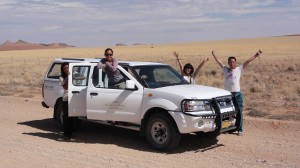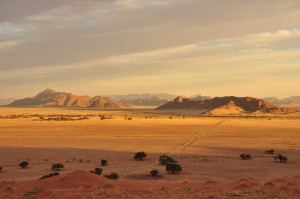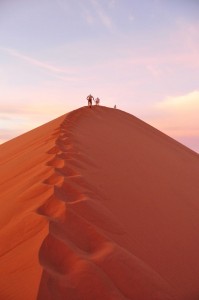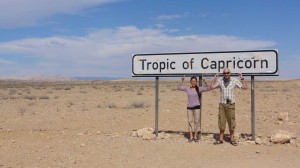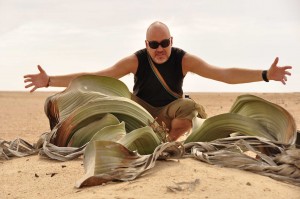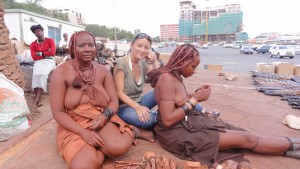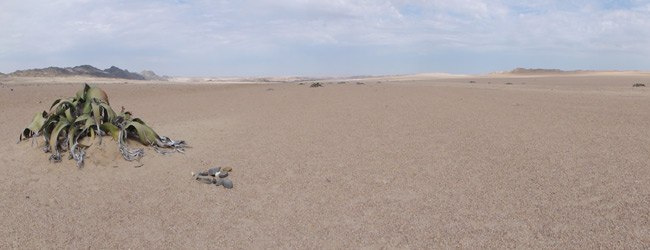Namibia is about the size of Pakistan, with a population of only 2 million. The place is pretty much empty of people, but home to some amazing natural landscapes, national parks, ancient tribes and the worlds oldest deserts. The deserts are what attracted us here. A chance to soak up some amazing, surreal scenery and scratch a few photographic itches bred of our latest travel investment – a new Sony digital camera that takes 180 degree panoramic photo’s and maps GPS / compass data. (like we needed more toys, but anyway!)
From Capetown we had caught a surprisingly comfortable 20 hour bus to the Namibian capital of Windhoek. Staying at the Chameleon Backpackers, it was our plan to try some meet people there who might be in interested in hiring a car. As empty as inland Australia, to get anywhere in Namibia you need your own 4 wheel drive or else be willing to shell out $500+ minimum per person to join a tour or Safari for a few days. Chameleon was a backpacker hub, a highly organized, pleasant set-up and bustling connection point for other travellers in Namibia – we figured it our best bet for some spontaneous recruitment. On arrival though, after the marathon bus trip I promptly passed out, only to wake up 3 hours later and find that Megumi had already befriended a group of other long term Japanese travellers, (both starting out and 1 years / 3 years into their respective trips) and another Korean girl. 3 of whom were up for pooling resources. Job done!
Accompanied by Hiro, Shimche, and Tacto – we grabbed a 4×4, hired a tent for 3 days (All of which, plus fuel worked out to be a netcost of $120 pp) and set out on the 6 hour drive to the Namib desert, the oldest desert in the world and famous for its red sand dunes and the extremely photogenic Dead Vlei. The drive itself was fantastic though challenging, less than an hour out of town we hit gravel road, the last we would see of bitumen for the next 2 days. From the typical savannahs of the African plains, the landscape slowly gave way to rocky hill outcrops reminiscent of Hampi in India and transitioned into flat, treeless plains with rocky peaks spanning the horizon in every direction. As we got closer to the Namib, these rocky hills took on stranger and stranger hues and took on a magical Alien air – it was not a great leap to see ourselves exploring Mars in a rover here. Arriving at the central entrance to the Namib National Park in Sesriem around mid-afternoon, we quickly set up our tents at the campground and made a quick dash for the Ellingen dune to view the sunset.
Climbing a sand dune is a lot harder than it sounds and is exhausting work, each foot sliding down and back, it really does take twice the effort to get anywhere. The horizons at sunset were well worth it though. Spectacular panorama’s aplenty in all directions; as the sky slowly worked through a cascading series of soft pinks, purple and redish tones, magnificently contrasted by the red sand of the dunes themselves and the rocky panorama’s in every direction.
The next morning we got up early (4am) and lined up at the park gate for the 5am opening and sunrise dash. Our aim was to drive the 45 km to get to Dune 45 (naming obvious) and climb-up for the sunrise. This quickly took on a ‘right of passage’ almost ritual feel, as we proceeded in procession with a score of other 4×4’s, safari jeeps and customized tour vehicles into the darkness, out deep into the desert. On arriving at Dune 45, we quickly disembarked and climbed the 500m great red dune ridgeface to the top with the other like minded early risers. The growing light, revealed hundreds of red sand dunes parading themselves on all sides, slowly shifting colours as they danced to the prospects of the new day. The trip down was much more expedient and fun, a series of orchestrated sprints by all straight down the steep inclines.
Next stop was Dead Vlei in Soussvlei, much deeper in, but accessed via a sandy, 4×4 track, 5km into the desert basin. I have driven 4×4’s a few times, but wheels deep in up to a foot of sand was quite different. About halfway in, we got a bogged in the sand, not once but 3 times. Our tires buried half way up, I suddenly had the sinking feeling that we would spend the rest of the day trying to get out, (ironically powered by Asian push power). Thankfully a “not too happy tour guide” stopped by and with a ‘look that said it all’ put my car into the correct “Low Gear”, so that we could continue forward. Obviously we are far from the first tourists he has had to teach how to drive here, probably not his first today even judging by his demeanour. From there, we made the 1km walk over some dunes to the stunning white clay flats, dead tree’s and the huge red sand dune backdrops that make up the Dead Vlei. The movie, “The Cell” was shot here, so it was a very familiar sight and incredibly photogenic and fun, before the desert heat kicked in at least.
Leaving the red dunes, we then drove across to Swakopmund, an arduous 6 hour drive along gravel roads winding through the Namib National Park North to the coast, but another continual progression of stunning backdrops, changing desert landscapes and strangely coloured hills. Swakopmund is a strange town. A German colonial city that looks like a movie set and completely out of place in the middle of desert. The town is a cute, progression of classic Hans Christian Anderson architecture on the beach, its prison a fairy palace. This is a big tourist destination apparently, South Africans come for beach / fishing escapes, Angela Jolie and Brad Pitt come here to have babies – entirely pleasant as it was, it was hard to know what to make of it.
Ahead of a drive back to Windhoek, we wanted to see the world oldest plants and surrounding moon landscapes; so had planned on an exploratory drive into the surrounding deserts with little maps or information. The moon landscape was easy to find, a jagged landscape of large grey hollows and thousands of what appeared to be impact craters. The Wilwitschia took some more work and faith though – down a dirt road into endlessly flat desert sand plains, until we finally spotted a few plants amongst the desert scrubs. Driving on we came across a large section of desert dominated by the huge, obviously greatly aged plants. The Wilwitscchia is the world’s oldest plant and found only in the deserts of Namiibia. It has 2 leaves that shred over time emerging from a central wooden cocoon; males with spores, females buds. They have a strange peaceful aura, somehow in the middle of nowhere they have managed to live through it all – hard to fathom that some of the ones we were looking at had existed before Jesus.
On returning to Windhoek, (by proper road this time), we said our goodbyes to the rest of the crew and checked into Backpacker Unite. Well hosted and Megumi happily entertained a 5 beautiful cats, we stayed up very late into the night exchanging travel tales with the owners.A Namibian born of South African decent and his wife. He had served in the army during the conflicts with Angola and had some fascinating insights into recent Namibian history, its parallels with South African apartheid and its other tribal / political idiosyncrasies.
We had decided to forego the Etosha national park this trip, thinking we were a bit safari’ed up and still had Kenya / Tanzania to go, we had however wanted to visit the Hemba triba in the Northern part of Namibia. The Hemba are a beautiful tribe who still stick very strongly to their old ways, their women reknowned for their beauty and cover themselves in red mud. You need special permission to visit though and require a guide etc, so it had seemed a little too difficult (and expensive) to incorporate into our trip this time. But as luck would have it, there we were wandering around the markets in Windhoek when we spied 3 half naked, mud covered women selling crafts. A quick chat, a souvenir and a photo and Wham, Bam, Thankyou Namibia! Another 20 hour bus ride across the Kalahari desert to Livingstone, Zambia!
![A Desert Road Trip in Namibia Namibia is about the size of Pakistan, with a population of only 2 million. The place is pretty much empty of people, but home to […]](http://meltingplots.com/wp-content/uploads/2010/04/DeadVlei.jpg)
